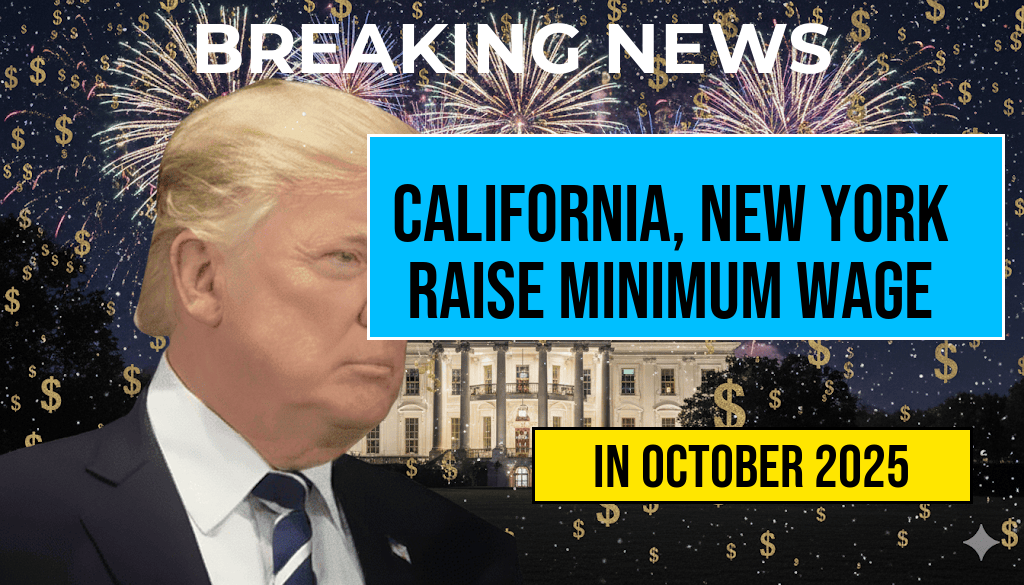California and New York are set to implement significant increases to their minimum wages, with both states raising the hourly rate to $16.50. The change reflects ongoing efforts to boost earnings for low-wage workers amid rising living costs and economic recovery efforts post-pandemic. In California, the increase will take effect in 2024, impacting hundreds of thousands of workers across various industries. Meanwhile, New York’s adjustment will be phased in over the next year, gradually reaching the new minimum. These moves are part of broader state-level initiatives aimed at reducing income inequality and strengthening the economic stability of vulnerable populations. The wage hikes come amid debates over the pace of minimum wage increases nationwide, with advocates emphasizing the need for living wages and opponents warning of potential impacts on employment and small businesses.
California’s Path to a $16.50 Minimum Wage
California’s minimum wage will rise to $16.50 per hour statewide on January 1, 2024. This marks a substantial jump from the previous threshold of $15.50 for large employers, which has been in place since 2023. The state’s wage laws, enacted through a series of phased increases, aim to reach a $15.50 baseline by 2023, with further adjustments pushing wages higher over subsequent years.
The increase is part of California’s broader efforts to address income inequality. According to the California Department of Industrial Relations, approximately 3.8 million workers are expected to benefit directly from this change, including those in retail, hospitality, healthcare, and other service sectors. The state’s minimum wage laws apply to most employers with 26 or more employees, while smaller businesses are provided with extended timelines for compliance.
Economic Impacts and Industry Response
While proponents argue that higher wages will boost consumer spending and improve quality of life, critics have voiced concerns about potential job losses and increased operational costs. Small business associations warn that rising labor costs could lead to layoffs or higher prices for consumers, especially in highly competitive sectors.
| Year | Minimum Wage (Large Employers) |
|---|---|
| 2023 | $15.50 |
| 2024 | $16.50 |
| 2025 and beyond | Adjustments tied to inflation |
New York’s Gradual Increase to $16.50
New York is also moving toward a $16.50 minimum wage, with scheduled increases set to occur over the next 12 months. The state’s minimum wage varies by region, reflecting differing economic conditions. For example, in New York City, the current minimum is already at $15.00, but the state plans to elevate it to $16.50 by the end of 2024. In rural and less densely populated areas, the increases will be phased in more gradually, with some regions reaching the target rate in 2025.
The New York State Labor Department has emphasized that these adjustments are designed to support workers without unduly burdening employers. The phased approach aims to balance economic growth with social equity, especially in sectors hit hardest by inflation and labor shortages.
Legal Framework and Future Outlook
Both states’ wage hikes are grounded in legislation passed by their respective legislatures, with support from labor unions and advocacy groups. These laws also include provisions for regular reviews to ensure wages keep pace with inflation and economic changes, aligning with broader policy goals to eradicate poverty and promote fair wages.
Economists and policy analysts continue to debate the long-term effects of such increases. Some studies suggest that modest wage hikes can stimulate local economies, while others warn about the risk of reduced employment opportunities if costs become prohibitive for small businesses.
Broader Context and National Trends
The moves by California and New York reflect a growing trend among states to set higher minimum wages than the federal level, currently at $7.25 per hour. Several states and cities have implemented plans to reach or exceed the $15 threshold in recent years, citing the need for wages that support a reasonable standard of living. According to the Wikipedia entry on minimum wage in the U.S., these state-level initiatives are shaping a patchwork of wage standards across the country.
The federal government has faced ongoing debates about raising the national minimum wage, but legislative progress has been stalled in recent years. As a result, states like California and New York are taking the lead in setting higher benchmarks, potentially influencing federal policy discussions in the future.
Implications for Workers and Employers
- Workers: The wage increases are expected to improve financial stability for millions, enabling better access to housing, healthcare, and education.
- Employers: Businesses may face higher labor costs, prompting some to adjust staffing or pricing strategies. Small businesses, in particular, are monitoring the changes closely.
- Consumers: Potentially higher prices for goods and services, especially in sectors heavily reliant on minimum wage labor.
As these policies take effect, continued analysis will be essential to evaluate their impacts on employment, inflation, and overall economic health. Both states have established mechanisms for monitoring outcomes and adjusting policies accordingly, signaling a commitment to balancing economic growth with social equity.
Frequently Asked Questions
What are the new minimum wage rates in California and New York?
The minimum wages in both California and New York will be increased to $16.50 an hour.
When will the new minimum wages take effect?
The new minimum wage rates are set to take effect on January 1, 2024.
How will the wage increase impact workers in these states?
The wage increase aims to provide higher earnings for low-income workers, improving their living standards and financial stability.
Are there any differences in wage increases between different regions within these states?
Yes, certain regions may have different wage schedules or gradual implementation plans, but the minimum in both states will reach $16.50.
Will the wage increase affect the cost of living or prices in California and New York?
It is possible that the cost of living or prices may rise slightly as a result of the wage increase, but the primary goal is to support workers and reduce income inequality.






